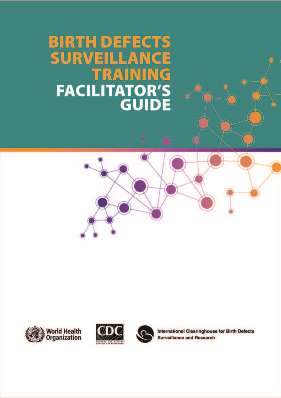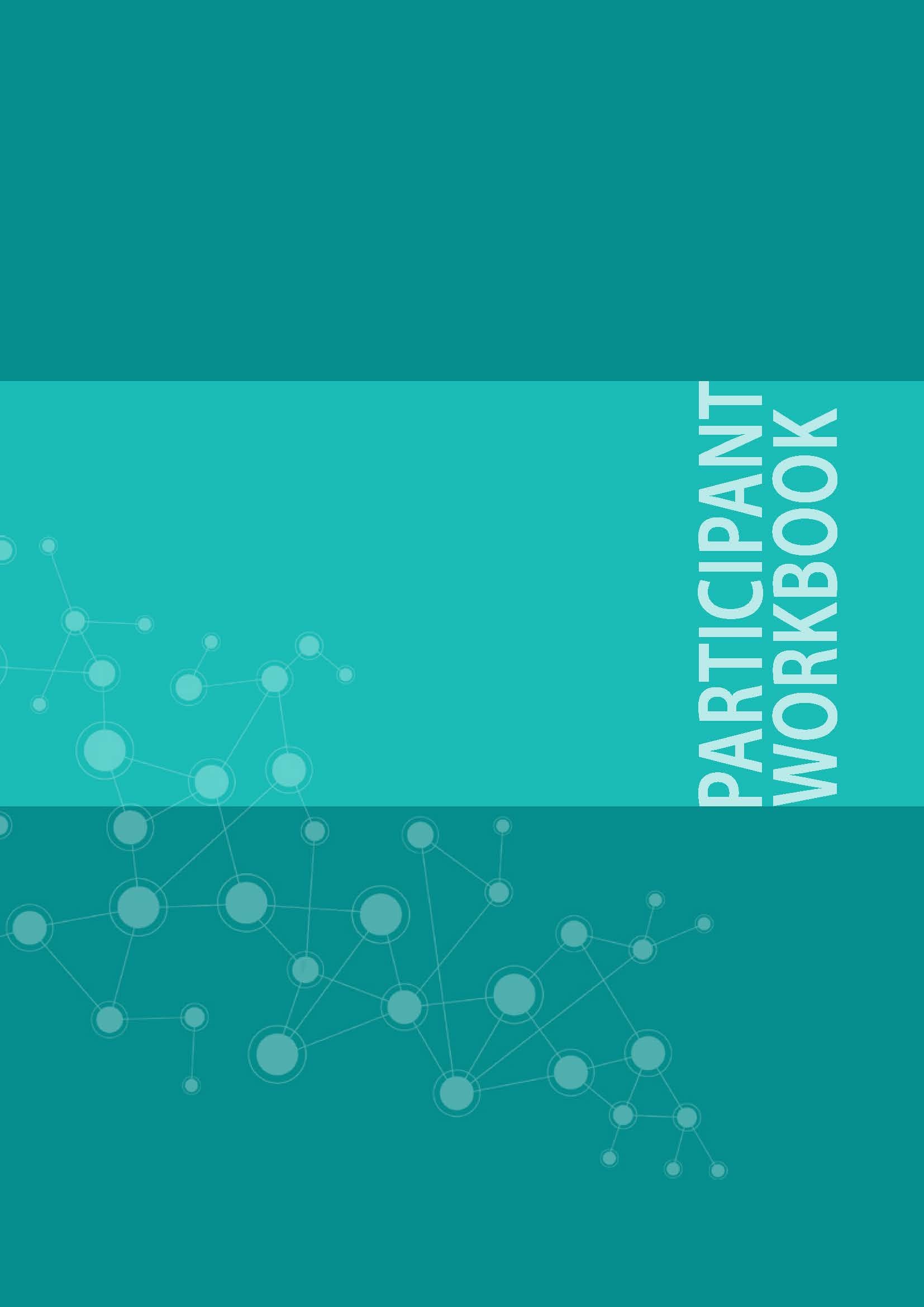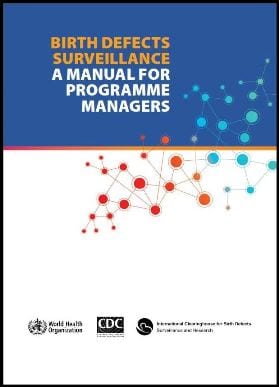Birth Defects Surveillance Course Overview
On this Page
The goal of this course is to provide participants with the foundational skills needed to begin the development, implementation and ongoing improvement of a congenital anomalies surveillance programme, in particular for countries with limited resources. It focuses on the methodology needed to develop either population-based or hospital-based surveillance programmes.
A set of congenital anomalies will be used as examples throughout this course. The specific examples used are typically severe enough that they would probably be captured within the first few days after birth, have a significant public health impact and, for some of them, have the potential for primary prevention.
Overview
This course is designed for individuals who are directly involved in the development, implementation and daily activities related to congenital anomalies surveillance programmes in their countries and who will directly teach others.
By the end of this course, participants will be able to:
- describe how to use data for the development of prevention campaigns and policy/programme evaluation;
- describe how to best present data to policy-makers;
- identify selected major external congenital anomalies for monitoring;
- describe the tools needed to ascertain and code congenital anomalies;
- describe the processes for managing and analysing data;
- demonstrate how to calculate the birth prevalence of congenital anomalies.
This course is based on a set of competencies that every participant is expected to learn during the course and subsequent practice and follow-up at their place of work. To become competent at something, a certain amount of knowledge is needed, as well as proficiency in certain skills. Table 1 lists the competencies for the course (column 1) and the knowledge (column 2) and skills (column 3) required for each competency.
| Competency | Knowledge | Skills |
|---|---|---|
| 1. Identify congenital anomalies | • Define congenital anomalies • Describe terms that are used as synonymous with congenital anomalies • List common risk factors associated with congenital anomalies |
• Recognize and explain major external congenital anomalies |
| 2. Describe public health surveillance | • Define public health • Define surveillance • Define public health surveillance • List the purposes of public health surveillance |
• Explain public health surveillance and its purposes to key partners |
| 3. Use logic models for surveillance of congenital anomalies | • Define logic models • List the components of logic models • Describe how logic models can support programme planning |
• Create a logic model for congenital anomalies surveillance • Revise a logic model as a programme evolves |
| 4. Help engage partners for a congenital anomalies surveillance programme | • List partners and their potential role(s) • Describe different ways to communicate with different groups of partners |
• Apply competencies • Identify key partners as appropriate for a country or setting • Advocate with key partners using the logic model |
| 5. Help set up a reporting system for congenital anomalies surveillance | • List advantages and disadvantages of mandatory and voluntary reporting • Describe confidentiality and privacy issues to be considered when setting up a reporting system for congenital anomalies surveillance |
• Develop a reporting system |
| 6. Define the surveillance programme that is most appropriate for a given setting | • Define the population under surveillance • Identify areas of coverage • Define population-based and hospital-based surveillance programmes • List advantages and disadvantages of each type of surveillance programme • List factors to consider when deciding the most appropriate surveillance programme |
• Select the surveillance programme that is most appropriate, considering the population under surveillance and areas of coverage • Select the population under surveillance • Select the geographic area under surveillance |
| 7. Determine how to ascertain cases | • Describe case-ascertainment approaches • List advantages and difficulties related to each approach • List potential data sources • Describe the different characteristics to be considered for case inclusion • Describe potential case inclusion/exclusion criteria, according to the type of surveillance • List core variables to be included in a surveillance programme |
• Help identify the best ascertainment approach in a given setting • Define cases to be included, as appropriate for a given setting • Define data sources that will be used • Define core variables to be considered for a given surveillance programme |
| 8. Help set up a coding system for a congenita lanomalies surveillance programme | • Describe methods for describing congenital anomalies in the data-collection process • Define the international standard diagnostic classification system • Describe ways to improve the coding system for certain congenital anomalies not thoroughly addressed in the International statistical classification of diseases and related health problems,10th revision (ICD-10) (3) |
• Help identify a coding system using the ICD-10/Royal College of Paediatrics and Child Health (RCPCH) coding system • Assign appropriate codes to diagnoses of congenital anomalies |
| 9. Help to disseminate congenital anomalies surveillance data | • Describe the use of data • List potential end users of the data • Describe the dissemination method that is most appropriate for each stakeholder/audience |
• Develop dissemination messages according to different audiences • Help develop dissemination tools |
| 10. Use public health surveillance for a congenital anomalies programme | • List the objectives of a congenital anomalies surveillance programme • Describe the main types of congenital anomalies surveillance programmes • List potential congenital anomalies that will be collected by the surveillance programme |
• Explain how to develop a congenital anomalies surveillance programme • Identify the congenital anomalies that will be collected by the surveillance programme |
| 11. Help identify the best congenital anomalies surveillance programme for a given setting | • Describe key components that will influence which surveillance programme is most appropriate for a given setting | • Apply competencies to a decision about which surveillance programme is most appropriate for a given setting • Describe the congenital anomalies surveillance programme that is most appropriate for a given setting |
Conducted in its entirety, the course length is approximately 4–5 days. However, the actual length will depend on the needs and experience of the country and the participants; therefore, the facilitator will need to decide which chapters to cover and adapt the time frame of the course accordingly. The sessions use a variety of teaching methods, including lectures, demonstrations and work in smaller groups, as well as practicums and exercises.
Course Materials

The Facilitator’s guide contains what you, the facilitator, need in order to lead participants through the course. It contains detailed instructions on how to conduct each session. This is your most essential tool as a facilitator. It is recommended that you use it at all times and add notes to it as you work. These notes will help you in future courses.

The workbook, which can be found at the end of the Facilitator’s guide, is to be provided to participants on the first day of the training, and includes specific activities that they will do by themselves or in groups during the training. One copy of the participant workbook should be made for each participant.
Many sessions use slides. These are provided on a CD for projection onto a screen, or can be downloaded from a site. Please contact CDC for further details (birthdefectscount@cdc.gov).

The Birth Defects Surveillance: A Manual for Programme Managers can be used for reference after the course. If resources are available, provide a copy of the Facilitator’s guide to each participant, so it is not essential for participants to take detailed notes.
The Birth Defects Surveillance: Atlas of Selected Congenital Anomalies can be used for reference after the course; it can also be used for some of the coding activities during the training.
As a facilitator, you will need a flipchart, and blackboard and chalk, or white board and suitable markers, for most sessions, and a means of fixing flipchart pages to the wall or notice board – such as masking tape. You will also need a computer/laptop, an LCD (liquid-crystal display) projector and a screen.
Using the Facilitator’s Guide
Suggested actions and script for the facilitator are located in the “Script/key points” sections, to facilitate each session. Also included are references to the page numbers in the participant workbook, as well as instructions on when to use the activities. Use these materials as you prepare for your session, to guide you during the workshop. Be sure to refer participants to the appropriate page number in their workbooks throughout the session.
This course is intended to be used as a teaching guide and introduction to the WHO/CDC/ICBDSR Birth defects surveillance: a manual for programme managers. The facilitator will see in this guide that there are specific references to sections of the manual.
-
 Specific slide or PowerPoint presentation
Specific slide or PowerPoint presentation -
 Flipchart use
Flipchart use -
 Activity
Activity -
 Group discussion
Group discussion -
 Questions for facilitator to ask participants
Questions for facilitator to ask participants -
 Video presentation
Video presentation
Be completely familiar with this Facilitator’s guide before beginning a session. Make sure you are aware of what your responsibilities are, and read the “Objectives”, to find out what the participants should be able to do at the end of the session.
Read the text for the session, so that you are clear what you will have to do. The text includes detailed point-by-point instructions about how to conduct the session.
Consider splitting the session between two or more trainers, particularly if the session is long. Trainers can also work together, with one trainer writing on the flipchart or assisting with a demonstration while the other trainer is conducting the session.
Keep the Facilitator’s guide handy and use it as a reference during the training. You do not need to try to memorize what you have to do. It is extremely difficult to do so. Use the guide as your session notes, and follow it carefully. Also keep handy Birth defects surveillance: a manual for programme managers and Birth defects surveillance: atlas of selected congenital anomalies. It would be useful to have means that help you identify the sections of the manual and the atlas that relate to the session you are leading.
If the participants appear tired or their attention is wandering, the facilitator may consider pausing for a short break. Encourage everyone to stretch and take some deep breaths. Perhaps a short activity, song or game may revive them.
- World Health Organization. Congenital anomalies. Fact sheet No 370. October 2012 (http://www.who.int/mediacentre/factsheets/fs370/en/index.htmlexternal icon , accessed 29 April 2015).
- Resolution WHA63.17. Birth defects. In: Sixty-third World Health Assembly, Geneva,17–21 May 2010. Geneva: World Health Organization; 2010 (http://apps.who.int/gb/ebwha/pdf_files/WHA63/A63_R17-en.pdfexternal icon, accessed 29 April 2015).
- International statistical classification of diseases and related health problems, 10th revision. Geneva: World Health organization; 2015 (http://apps.who.int/classifications/icd10/browse/2015/enexternal icon , accessed 24 February 2015).
- World Health Organization, National Center on Birth Defects and Developmental Disabilities from the United States Centers for Disease Control and Prevention (CDC), International Clearinghouse for Birth Defects Surveillance and Research (ICBDSR). Birth defects surveillance: a manual for programme managers. Geneva: World Health Organization; 2014 (https://www.cdc.gov/ncbddd/birthdefectscount/documents/bd-surveillance-manual.pdf, accessed 10 February 2015).
- World Health Organization, National Center on Birth Defects and Developmental Disabilities from the United States Centers for Disease Control and Prevention(CDC), International Clearinghouse for Birth Defects Surveillance and Research (ICBDSR). Birth defects surveillance: atlas of selected congenital anomalies. Geneva: World Health Organization; 2014 (http://apps.who.int/iris/bitstream/10665/127941/1/9789241564762_eng.pdf?ua=1pdf iconexternal icon , accessed 10 February 2015).
- CDC Foundation. What is public health? (http://www.cdcfoundation.org/content/what-public-healthexternal icon , accessed 24 February 2015).